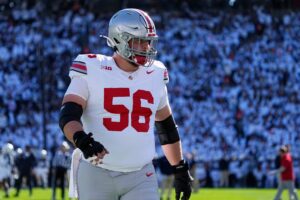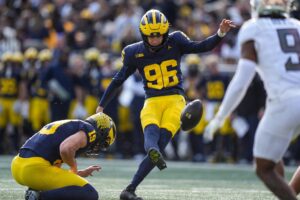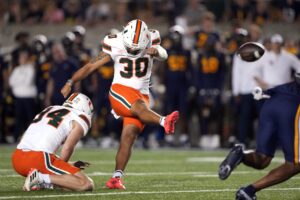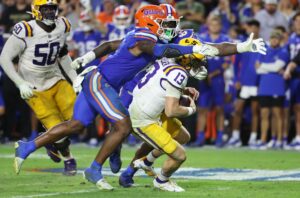Pac 12 commissioner Larry Scott continues to be faithful to the conference’s decision to shut down Fall sports. The Pac 12 remains steadfast in its decision of August 11th, despite acknowledging dramatically new circumstances.
Pac 12 Remains Steadfast But With A Lot Of Questions
Scott held a quickly called press conference Thursday afternoon to announce a partnership for the conference with Quidel Labs of San Diego. The lab is providing each campus in the conference with daily testing capabilities and rapid results, usually in 15 minutes. Scott shared the meeting announcement with Quidel Labs CEO Doug Bryant, Dr. Kim Harmon from the University of Washington and Dr. Doug Aukerman from Oregon State.
Scott said the conference medical staffs and the lab will also be using results to further research into the COVID virus.

Scott called it, “an important and significant step,” in getting back to being able to play college sports. But before anyone gets ahead themselves thinking this could impact football, Scott was adamant that the Pac 12 schools needed six weeks of training camp before being ready to compete. The testing equipment won’t be delivered to the campuses until the end of September. That would put the earliest start for any Fall college football at mid-November. “There is more to be done for sure in terms of working with public health officials. This is all very new.” In fact, Scott acknowledged he has yet to even confer with the athletic departments at any conference school.
The more likely scenario is that this moves a potential college basketball season for the Pac 12 up by about a month, into late 2020.

Scott repeatedly said the conference has six schools, (four in California and two in Oregon), that are still living under restrictions by county health directors. For UCLA and USC that would be Dr. Barbara Ferrer. She already notably outed UCLA for having football players with positive tests. In fact the information was nearly seven weeks old and no current players had a positive test. But he would not directly answer the question about how the Rams and Chargers are both in the same county as the two schools but will be playing starting next week. The same is true with the 49ers in Northern California.
As for the Oregon schools, Governor Kate Brown has said repeatedly that she would not make a decision that would put Oregon and Oregon State at a competitive disadvantage. In both states, the governors have the legal authority to override a county health director and grant waivers. But they have to be asked to do so. Scott repeatedly put local health officials up as an obstacle to playing college football in the Fall.
Standing By The Decision
Scott said, accordingly, he does not regret the decision made on August 11th to shut down the Fall sports season, even though the access to these rapid result tests answers the biggest issue the conference had at the time. “When we made our decision, it was mid-August, the week before training camp was supposed to start. And based on the fact that we did not have the requisite government approvals at that time, and had the uncertainties and concerns about the virus and it’s impact on young people. Frankly, I didn’t think we would have access until late November to the kind of testing we are talking about today.”
Dr. Aukerman said things are different now compared to when he was part of the Pac 12 committee that resided over the ceasing of Fall sports for the year. “Certainly the opportunity to test daily helps mitigate several of those concerns we had prior. But at that point and time we did not have the opportunity or ability to do point of care daily testing and didn’t see that on the horizon.”
Daily Testing
Dr. Harmon said the difference now with the ability for daily testing is that, “Our athletes will be no more at risk than the students that are on campus and maybe at less risk because of the frequent testing.”
The cost of such frequent testing has been a barrier for smaller schools around the country. It often was a mitigating factor in their suspension of Fall sports. Bryant said the cost of the tests was proprietary information. He did however acknowledge that the lab was already working with other individual schools across the country, including some that start playing football this month. “Yeah, we are with a number of universities that we have individually partnered with.”
Bryant said he had no authority to name them. But when asked how many partners the lab had that were currently playing football, he said, “It is several.” He later attempted to clarify that by saying not all of the schools already under contract with the lab had daily testing protocols, but they could if they requested them.
Is Myocarditis As Significant?
When the conference announced the cessation of Fall sports on August 11, the announcement cited growing concerns about the impact of myocarditis on the athletes. It was posited at the time that this was all new information. Thursday, Dr. Harmon said there has been an ongoing national study spearheaded by Harvard for some time. She said very preliminary data would be available in the next month or so, but that long term results would take considerable time.
Dr. Aukerman was not as concerned about the myocarditis as he was on August 11th. “I wouldn’t think we have to have absolute clarity. As everything with this Coronavirus, we are learning more about this virus and its impacts on the human body and how the human body responds to it on a weekly if not daily basis.” He went on to say that by having rapid results available on the COVID testing, it will allow doctors to better be able to isolate infected athletes and do a more thorough medical screening.
Earlier in the day, Dr. Wayne Sebastianelli of Penn State was quoted in another publication from a public school health forum Wednesday. He said that tests showed that 30-35% of Big 10 conference players who tested positive for COVID-19 had myocarditis. Penn State later issued a statement disavowing Dr. Sebastianelli’s claim. The statement said the doctor had no direct role in the research. It said he found out about the study through other colleagues. It stressed, that Dr. Sebastianelli did not know the actual published study reported a significantly lower amount of myocarditis incidents.
As for what is next, Scott stressed that the conference leaders would be, “nimble.” He has multiple “scenario committees” set up with the idea of looking at different possibilities based on evolving data and changes.
Still, since he is insistent on putting the weight of a football season on local health directors, it is more plausible that the new testing will first have a direct impact on the college basketball season.






